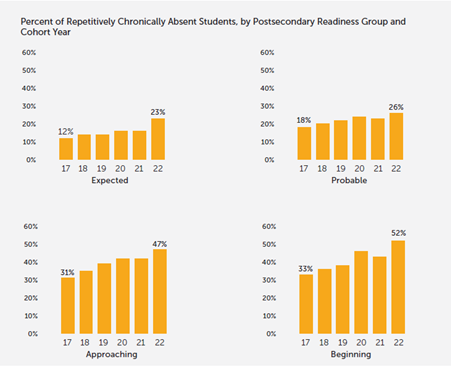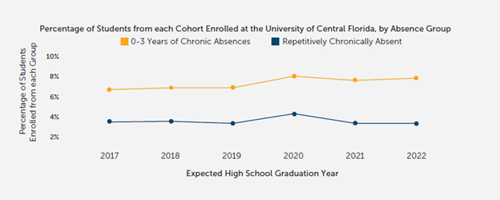Study: Rising chronic absenteeism in Central Florida linked to lower academic performance and university enrollment

Orange and Osceola School Districts See a 43% Jump in Absence Rates
ORLANDO, Fla. – Central Florida’s schools are experiencing an alarming surge in chronic absenteeism rates that threatens student academic achievement and postsecondary readiness. These are the findings from a new study by Helios Education Foundation and the Central Florida Education Ecosystem Database (CFEED), a collaborative data-sharing partnership among the School District of Osceola County, Orange County Public Schools, Valencia College, and the University of Central Florida (UCF).
The study examines chronic absenteeism patterns among 82,118 high school seniors from Osceola and Orange counties over five school years to assess its impact on academic performance and enrollment to Valencia College and UCF.
Researchers found that chronic absenteeism, and more specifically repetitive chronic absenteeism, increased from 23% among high school seniors in 2017 to 33% in 2022 – a 43% jump. Chronic absenteeism is defined in the report as missing 10 or more days of the school year. Repetitive absenteeism is defined in the report as missing 10 days or more of school in four or more school years. This differs from the Florida Department of Education’s definition, which is missing 10 percent or more of the school year.
“Chronic absenteeism has emerged as a significant concern not only in Central Florida, but also nationwide, posing a great challenge to individual student success and the vitality of our education systems,” said Paul J. Luna, President and CEO of Helios Education Foundation. “After already enduring unprecedented pandemic setbacks in education, this is a problem we can’t afford to overlook. We owe it to our students to ensure that they have every opportunity to thrive.”
The report shows a connection between students who were repetitively chronically absent and those who had low academic performances in commonly taken accelerated courses. About one-third of high school seniors in 2017 who were repetitively chronically absent were deemed “not yet ready” to take postsecondary coursework based on their low-performance. Among the 2022 cohort, nearly 50% of the repetitively chronically absent students were categorized as “not yet ready.”

Furthermore, while the study found no differences in enrollment rates at Valencia College among chronically absent and repetitively chronically absent students, there were clear differences at UCF. The data show students with fewer absences enrolled at UCF at rates that more than double those of students who were repeatedly chronically absent. Between 2017 and 2022, enrollment rates at UCF stood at nearly 8% for students with zero to three years of chronic absences, compared to almost 4% for students with repetitive chronic absenteeism.

“The ability for us to take a comprehensive look at student performances in Orange and Osceola counties from K-12 through college speaks to the invaluable partnership model of CFEED,” said Diana Pienaar, CFEED Director. “This data-sharing partnership model provides us with an ability to uncover deep insights around issues such as chronic absenteeism and then collaboratively drive informed decision-making to improve student outcomes."
The report also shows that repeated chronic absenteeism spiked the most among Black students with a 67% increase from 2017 to 2022, and among students who received free or reduced lunch, which saw a 58% increase in that same timeframe. English language learners and female students also saw some of the highest increases.

“Repetitive chronic absenteeism has disproportionately impacted traditionally marginalized student populations,” said Dr. Paul Perrault, Senior Vice President of Community Impact and Learning for Helios Education Foundation. “Black students, which had one of the lowest chronic absence rates in Central Florida pre-pandemic, saw the highest increase in repetitive chronic absenteeism between 2017 and 2022. This is a troubling trend that if left unaddressed could severely impact underrepresented and low-income communities.”
In the report, CFEED and Helios outline three steps schools and districts can take to reduce chronic absenteeism.
This report builds on the multi-layered efforts of Helios, across Florida and Arizona, to illuminate the challenges and promising solutions to chronic absenteeism among policymakers and stakeholders in education.
About Central Florida Education Ecosystem Database (CFEED)
Central Florida Education Ecosystem Database (CFEED) is a partnership, comprised of Helios Education Foundation, the School District of Osceola County , Orange County Public Schools , Valencia College , and the University of Central Florida , along with Midtown Consulting Group, creating a model of collaborative data sharing among Central Florida pre-kindergarten through university public educational institutions to identify factors that inform decisions and interventions, as well as to increase successes, outcomes, and opportunities for all students.